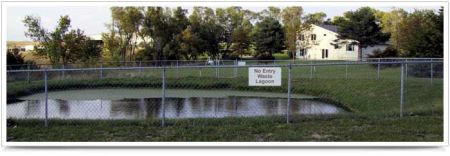Soils in southeastern Nebraska often have a high clay content, making septic systems unsuitable for wastewater treatment. Instead, a landowner in this area may have a residential wastewater lagoon. These treatment systems have their own maintenance requirements. Always minimize exposure to wastewater by wearing protective and waterproof gloves when performing maintenance tasks. After working around wastewater, thoroughly wash hands or shower, and disinfect any breaks in the skin.
At least once a month, check that the fence is intact and the gate secure. A lagoon must have a fence with a locking gate to prevent unauthorized entry. Children have drowned in lagoons. Dogs and other pets may wander into a lagoon for a recreational swim, especially on hot days. Later, anyone petting the animal may contact pathogens carried on the animal’s fur.
Also, check the lagoon dike for signs of erosion or burrowing animals. Any erosion or damage to the dike must be filled, compacted, leveled and reseeded to a perennial grass. Mulching helps control erosion until vegetation is established.
Manage vegetation in and around the lagoon. Maintain grass inside the fence to a height of no more than 6 inches. Tall vegetation restricts air flow, reducing evaporation from the lagoon. Cut to 3 inches often enough so no more than half the growth is removed at each mowing. Mow cool season grasses like fescue and bluegrass every two weeks in cool months, and monthly during hot weather. Do not let clippings fall into the water; totally removing clippings is a good option.
Maintain healthy perennial grass outside the dike. This grass should be vigorous and can be taller than grass inside the dike. Mow to stimulate a dense, healthy grass cover. Mow cool season grasses in early May and mid-June. Mow warm season types (native species) in early July and mid-August.
Do not allow trees and woody plants taller than the dike to grow within 50 feet of the dike. Air movement is necessary to provide oxygen needed by microorganisms that break down wastewater, and is also important for evaporation of wastewater. Trees and shrubs close to the lagoon restrict air flow and block sunlight that algae need to produce oxygen. In addition, roots may grow into the dike, providing channels that could lead to eventual degradation and failure of the dike.
Prevent rooted vegetation from growing in the lagoon. This will help reduce problems due to mosquitoes, aquatic animals and sludge accumulation. A minimum water depth of 2 feet helps prevent rooted plants from growing. The lagoon should have 2 to 5 feet of water in it at all times.
Prevent floating plants from growing in the lagoon. Floating plants like water lilies or duckweed block sunlight, preventing algae from thriving. Algae produce oxygen, which is essential for bacteria to make the lagoon function properly. If floating plants interfere with algae growth, the lagoon may begin to smell due to lack of oxygen. Floating plants may be physically removed or controlled with herbicides. Always act when plants first appear. Select a herbicide for the specific plants to be controlled that does not harm the algae or the environment. Dead plant material resulting from herbicide control adds organic load to the lagoon, which may cause odor and increase sludge accumulation.
These are some of the maintenance tasks; often it is merely a matter of doing a periodic check of the system, or managing vegetation that can be done as part of routine yard maintenance.

